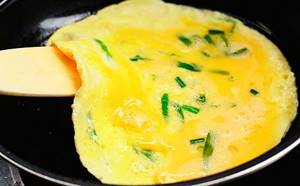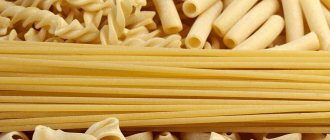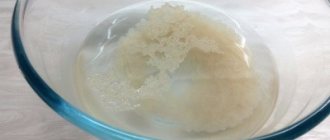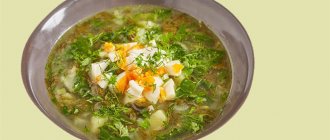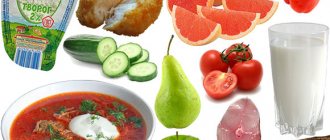Jan-15-2021 Author: KoshkaS
What is the calorie content of an omelet with milk from 3 eggs, what beneficial properties does it have? All this is of great interest to those who lead a healthy lifestyle and monitor their health and figure. So we will try to answer these questions in the next article.
So here it is:
Chicken eggs are a good source of biologically active components necessary for humans. Vitamins include vitamins A, B, B6, D and E, and folic acid (vitamin B9). The mineral composition is represented by iron, potassium, calcium, phosphorus, copper.
Eggs also contain essential amino acids and complete protein. At the same time, all of the listed substances are contained in the egg in an ideal balance, due to which they are absorbed by the body entirely.
One egg covers 25% of the daily amount of substances required by the body. Therefore, it is recommended to eat 2 eggs per day - in the form of an omelet and boiled.
But it is better not to eat raw eggs - they contain substances that interfere with the absorption of certain vitamins.
Egg yolk contains vitamins B2, B12, A, D, lutein, iron, lecithin, and selenium in sufficient quantities. In addition, eggs can become a substitute for the best varieties of fish due to the presence of polyunsaturated fats and amino acids in them.
Chemical composition
Omelette is a pretty healthy dish. It contains many nutrients, vitamins and minerals that are directly involved in the functioning of the body. This product is a source of vitamins such as:
- A, C, D, E;
- almost the entire group B;
- RR, N.
They take part in metabolism and support visual functions. Thanks to them, our skin maintains its firmness and elasticity. Vitamins affect the metabolism of fatty acids and cholesterol, participate in the synthesis of hormones and prevent anemia. They support the activity of the reproductive system and liver function. Vitamin D regulates the amount of phosphorus and calcium, thus ensuring bone strength.
If you regularly include this dish in your diet, then you do not suffer from mineral deficiency. In an omelet they are found in a wide range. 100 g of product contains the following elements:
- chlorine – 1132 mg;
- phosphorus – 153 mg;
- potassium – 150 mg;
- sulfur – 117 mg;
- sodium – 106 mg;
- calcium – 93 mg;
- magnesium – 13 mg;
- copper – 57 mcg;
- fluoride – 40 mcg;
- aluminum – 23 mcg;
- iodine – 15 mcg;
- strontium – 8 mcg;
- molybdenum – 7 mcg;
- cobalt;
- manganese;
- tin;
- selenium;
- chromium;
- zinc.
Important! The dish also contains dietary fiber, organic acids, cholesterol and sugars. Naturally, most of the omelet owes such a varied composition to eggs, covering the need for nutrients by 25%.
Nutritional value and benefits of omelet
Nutritional value of omelet per 100 g: fats - 7.5 g, proteins - 8.6 g, carbohydrates - 2.3 g. The composition also includes vitamins, amino acids and macroelements. What are the benefits of scrambled eggs and how does their nutritional composition affect our body?
- Vitamin A. An essential antioxidant for healthy skin, teeth and bones.
- B vitamins. Maintain a normal nervous system and muscle tone, speed up metabolism.
- Vitamin D. Strengthens blood vessels, prevents skin aging.
- Lutein. Reduces blood cholesterol levels.
- Potassium, phosphorus, iron, folic acid, copper - maintain the body's immune system normally.
Omelette is also useful for gastritis and other diseases of the gastrointestinal tract. It is the steamed omelet that is included in diets for diseases of the digestive system, both for high and low acidity. The dish is a gentle, soft and not heavy food.
Harm or contraindications
Not so much the dish itself, but its main component - eggs - can harm any healthy body if you are careless about their choice. They are the main carriers of salmonellosis. Therefore, you should not drink raw eggs if you are not sure of their quality.
In addition, consuming large amounts of protein can lead to kidney failure, as well as an increase in cholesterol levels, which causes atherosclerosis. The daily norm for an adult is no more than 3 eggs.
And an equally important point - a steamed omelette is healthier than one cooked in a frying pan. High levels of carcinogens that are released when vegetable oil is heated promote the formation of cancer cells.

How many calories are in an omelet?
KBZHU dish, that is, its calorie content and BJU content per 100 grams is:
- calorie content – 120 kcal;
- proteins – 10 g;
- fats – 16 g;
- carbohydrates – 2 g.
Important! These figures are averages and relate exclusively to the standard set. In general, the classic omelet is a French dish that is prepared from eggs alone. They are mixed, but not beaten, add salt and pepper. Then fried in butter. Contrary to popular belief, a French omelette should not be airy, so it is prepared without covering the pan. First, fry one side of the pancake, then turn it over to the other. When ready, it is usually rolled into a tube.
In France they say that any self-respecting chef must, first of all, be able to cook an omelet. In our country, the dish is prepared with great variety, expanding it with various ingredients, for example, with vegetables. Omelette with tomatoes, onions, bell peppers, and herbs is very popular. Some people prefer to roast it with broccoli. To increase the satiety of the dish, it is made with ham or sausage, sausages, seasoned with cheese and seafood, bacon, boiled rice, mushrooms and even pasta are added. When frying, use lard instead of oil. For those who adhere to a diet, they have to be content with an omelette on the water.
Important! Depending on the products included in the dish, its calorie content also changes.
With milk
This cooking option is considered traditional for us. It is prepared quite simply. You should adhere to the following steps:
- 1 egg is mixed with 25 ml of milk;
- beat the mixture until smooth, then pepper and salt;
- Place a small amount of butter on a hot frying pan (you can replace it with sunflower oil);
- pour the egg-milk mixture, cover with a lid and simmer over low heat until cooked.
The number of calories per 100 g of each ingredient is as follows:
- egg – 157 kcal;
- milk with fat content 3.2% – 60 kcal;
- Butter “Krestyanskoye” – 660 kcal.
The calorie content of a dish depends on the number of ingredients. For an omelet made from 1, 2, 3 and 4 eggs, it will not be the same. So, if a dish is prepared with 1 egg, it contains approximately 106 kcal, from 3 - 125 kcal.
With tomatoes
If an omelette with tomatoes is prepared with the addition of milk, then its calorie content is 150 calories per 100 g. But you can prepare the dish without milk, because the tomatoes will release quite a lot of juice. The cooking process is as follows:
- cut 100 g of onion into half rings and fry it, stirring constantly, in olive oil;
- add 200 g of tomatoes, cut into slices, and simmer for another 2 minutes;
- beat 2 eggs, salt and pepper the mixture, pour it over the vegetables;
- keep the mixture on the fire until fully cooked.
Lush omelette
Many people remember the airy and tall piece of omelette from kindergarten. But in ordinary life we prepare it completely differently. There are recipes for a lush omelette made from milk and eggs, both in a frying pan and in the oven.
4 cooking secrets
- Proportion of milk and eggs. For 1 egg there should be 100 ml of milk. This is the perfect proportion.
- Don't beat the eggs. Do not use a blender or mixer. Mix eggs with milk using a whisk or fork.
- Don't add flour. This will make the omelette more tender and soft in taste.
- Do not open the lid. If you are preparing a dish in a frying pan, do not open the lid during cooking, otherwise the omelette will not rise. And if in the oven, do not open the door until the end of baking.
You will need:
- eggs - 4 pieces;
- milk - 400 ml;
- salt, spices - to taste;
- vegetable oil - 1 teaspoon.
Preparation
- Mix eggs with milk, salt and spices.
- Grease a baking dish or frying pan with vegetable oil.
- Pour the mixture to half the container and place in an oven preheated to 200 degrees and bake for 30 minutes. Or place the frying pan over medium heat, and after the mixture has set, cover with a lid, set the heat to low and simmer for about 20 minutes.
How to reduce the calorie content of an omelet?
A low-calorie omelette can be obtained by eliminating oil from its composition. But you need to understand that in this case it should be cooked in one of the following ways:
- in the oven;
- in a slow cooker;
- in a steamer;
- in the microwave.
Or you can use a regular package. To do this, pour a beaten mass of 3 eggs and 150 ml of milk into a bag and tie it tightly. For reliability, the resulting bag is placed in another one, also tied well. Pour 1 liter of water into a saucepan and place on fire. Gradually lower the bag into boiling water. Cook the mixture over low heat for 25 minutes. The calorie content of the dish will be 85 kcal.
Another way to reduce the fat content of an omelet is to make it with only whites and replace the milk with water. If you can’t give up yolks, then reduce the number of eggs altogether. For example, instead of 2 eggs, take one and replace the second with vegetables and herbs. Use dill, basil, parsley. For true gourmets, oregano, cilantro, rosemary or celery are suitable.
Boiled fluffy omelette
There is a recipe for a classic omelette in a frying pan that is dietary and healthier. The unusual idea of a boiled omelet is relevant for those who are watching their figure, as well as for young children. This cooking method is good because you don’t need to watch for burning during the process, turn it over, or reduce the heat. The dish will be prepared without your participation.
You will need:
- eggs - 3 pieces;
- milk - 150 ml;
- salt, spices - to taste;
Preparation
- Beat the eggs with salt with a mixer or whisk until fluffy.
- Pour in the milk and beat again.
- Take 2 baking bags (if you don’t have them, you can use regular plastic bags). Pour the whipped mixture into them. And leaving a little space, tie it in a strong knot.
- When the water in the pan boils, place the bag in it and cook for 30 minutes over medium heat. Do not cover with lid.
- When the dish is cooked, remove the contents, cut the bag and serve.
To know how to cook an omelet from eggs and milk and make it perfect, you will have to practice more than once. Choose the right temperature, maintain the exact proportion of eggs and milk (kefir or water), use convenient dishes (including a non-stick frying pan, a wooden or plastic wide spatula). And then a regular omelet recipe will significantly save you time and lift your spirits.
Ways to reduce the calorie content of an omelet
- We prepare the product using household appliances. An omelet in a slow cooker or double boiler has slightly fewer calories. Naturally, such an omelette will not have the delicious crust that many people love;
- We reduce the number of eggs in the omelet to a reasonable limit and add various vegetables, herbs, do not use mayonnaise and ketchup;
- We prepare the omelette without yolks, using high-quality water (melt). Any lazy person who has a refrigerator with a freezer can prepare melt water;
- We prepare an omelette without using any oil (even the “favorite” of all nutritionists, olive oil).
How many calories are in a 2 egg omelette with milk?
The calorie content of 100 grams of an omelet made from two eggs is 172 kcal. That is, the calorie content of an omelet made from two eggs increases by the energy value of one egg (approximately).
After such a simple conclusion, it is easy to answer the question: “How many calories are in an omelet of 3 eggs with milk?” - 216 kcal.
You can reduce the calories in this omelet recipe by replacing the milk with water. After all, the calorie content of an omelet with milk is much higher than that of a cooked product with water.
And then the admirer of chicken eggs will not ask the question that is framed in the subtitle, but only: “How many calories are in an omelet made from 2 eggs?”
Below we will look at ways to reduce the calorie content of an omelet made from 2 yolks and 3 whites of eggs with milk.
How many calories are in an omelet with tomatoes?
The calorie content of an omelet with tomatoes increases by the energy value of vegetables: 100 g of tomato – 30 kcal. An omelet with tomatoes produces more liquid, which can be removed in various ways.
Tomatoes, bell peppers, pre-fried onions can be placed:
- In an omelette with sausage;
- In an omelette with ham;
- In an omelette with sausage;
- In an omelet with cheese, lard and other products with a high degree of fat content.
Nutritionists rightly believe that, taking into account the quality of modern sausage and dairy products, it is better to dilute an omelet with vegetables with “good” water, fry in vegetable (olive) oil, without any meat additives at all, sprinkle the finished product with various herbs (dill, parsley , basil). To reduce the energy value of an omelet, you can remove the yolk from the eggs by adding a certain amount of flour to the omelet (exactly how much depends on the person’s culinary preferences).
With ham or sausage
It’s a tasty dish, but it’s a stretch to call it healthy for several reasons: it’s cooked in a frying pan, which means it contains carcinogens; fried sausage hardly fits the definition of “healthy food.”
| Components: | 4 egg whites; 150 grams of sausage or ham; a little butter; greens to taste; milk 2 tablespoons. |
| Cooking method: | Mode Dice the ham or sausage and fry it in a frying pan until half cooked, you can add onion or garlic, but it all depends on preference. Beat the whites together with milk, add salt and pepper, and throw in a piece of butter. Pour into a frying pan. Fry on one side for 3 minutes, then cover the dish with a lid, after 3 minutes it will be ready. |
How many calories are in an omelet without butter?
Calorie content of 100 grams of various oils with which most people prepare omelettes:
- Olive – 198 kcal;
- Sunflower – 578 kcal;
- Creamy – 748 kcal;
- Peanut and corn - 899 kcal each.
We remove 20 - 30 grams of oil from the recipe, and we get a significant saving in kilocalories consumed. Of course, you won’t be able to fry an omelette in a frying pan on a gas stove without any oil, but preparing a delicious product in the oven or slow cooker is easy and simple. You can also cook an omelet without oil in the microwave, but...
6. Omelette of 2 eggs with milk and tomatoes
The kilocalorie content in an omelet made from two eggs depends on their size and weight - it can vary from 30 to 70 grams, that is, the average value will be somewhere around 40 grams.
The calorie content of a simple omelet made from two eggs and milk, cooked with a minimum amount of butter, is 161 kcal.
The most popular variation of this dish involves adding tomatoes.
An omelette made with milk with two eggs and the addition of a tomato contains 151 kcal per 100 grams.
To reduce the energy value of the dish, you can use skim milk or use a few more techniques.
7. How many calories are in an omelet made from 1 egg and milk?
The calorie content of this recipe depends on the method of preparing the dish: in the oven, in a slow cooker, fry in a frying pan on a gas stove.
Preparing an omelet by frying on the stove is the most high-calorie and “dangerous” option for the body: during frying, carcinogenic substances are formed to a greater or lesser extent in various fats, which negatively affect metabolic processes in the body.
Delicious and simple classic recipe in a frying pan
Cooking tips
To fry a regular omelette in a frying pan according to any recipe, you should choose only fresh chicken eggs. Before cooking, remove them from the refrigerator to allow them to come to room temperature. It is more convenient to fry the omelette in a frying pan with a thick bottom, for example, cast iron. But since not everyone has one, you can take a frying pan with a non-stick coating. An important rule is that the frying utensils must be dry.
Many people are concerned about the calorie content and benefits of a dish cooked in a frying pan. How to prepare an omelet without oil? Unfortunately, without the use of oil, it is cooked only by steaming. For those who are on a diet, you can lightly grease the dishes with olive oil. And one teaspoon of sunflower oil will not do any harm. But butter will give a special soft taste and aroma.
Step by step recipe
You will need:
- eggs - 2 pieces;
- milk - 50 ml;
- salt, spices - to taste;
- vegetable oil - 1 teaspoon;
- greens - several sprigs of dill and (or) parsley.
Preparation
- Beat the eggs with a mixer. First at low speed, then at maximum speed.
- Add milk, salt, spices. Beat well again.
- Heat the frying pan well. Grease with vegetable oil.
- Pour in the beaten egg mixture. Cook over medium heat for 2-3 minutes. Then set the heat to low, cover and cook for another 3-4 minutes until hardened.
- Serve the finished dish with chopped herbs.
Turn over easily and correctly
How to make an omelet from eggs and milk in a frying pan? And how to fry it on the other side? Very simple.
- Use a pot or frying pan lid. When the dish is cooked on one side, take a wide flat lid with a comfortable handle, cover the pan and turn the egg mixture onto the lid.
- Place the frying pan on the heat and remove the inverted omelette from the lid. It is better to take a lid made of ceramics or glass-ceramics - the mass will slide off easily and will not be damaged.
- Add grated cheese. You can add grated cheese to the recipe for an omelet with milk and egg in a frying pan. Then the mixture will be denser and will not fall apart, so it will be easy to turn over.
